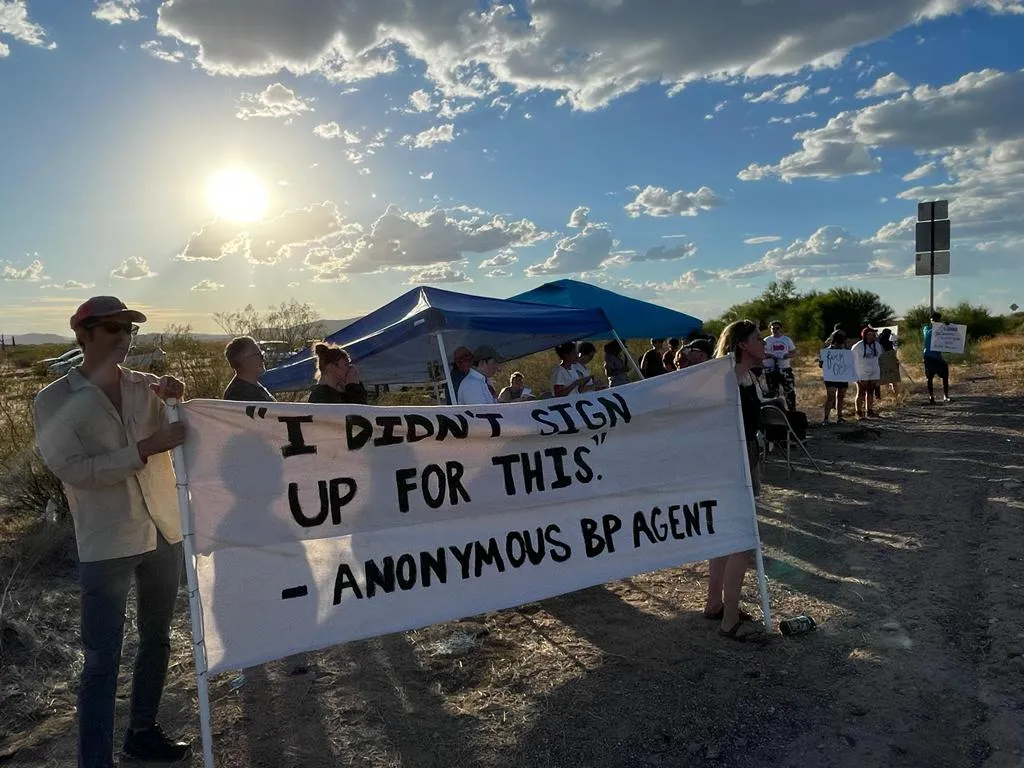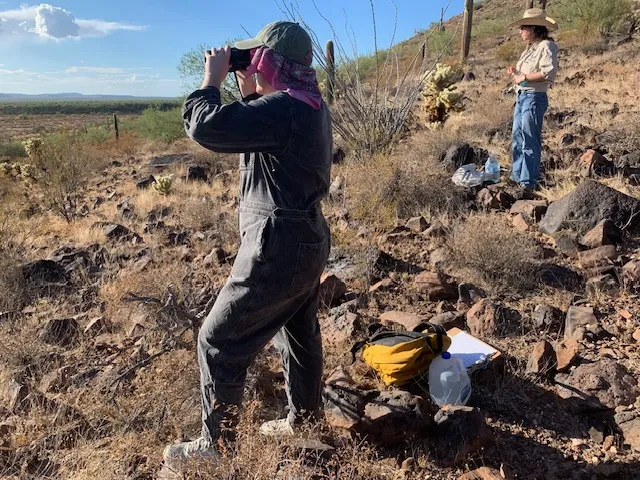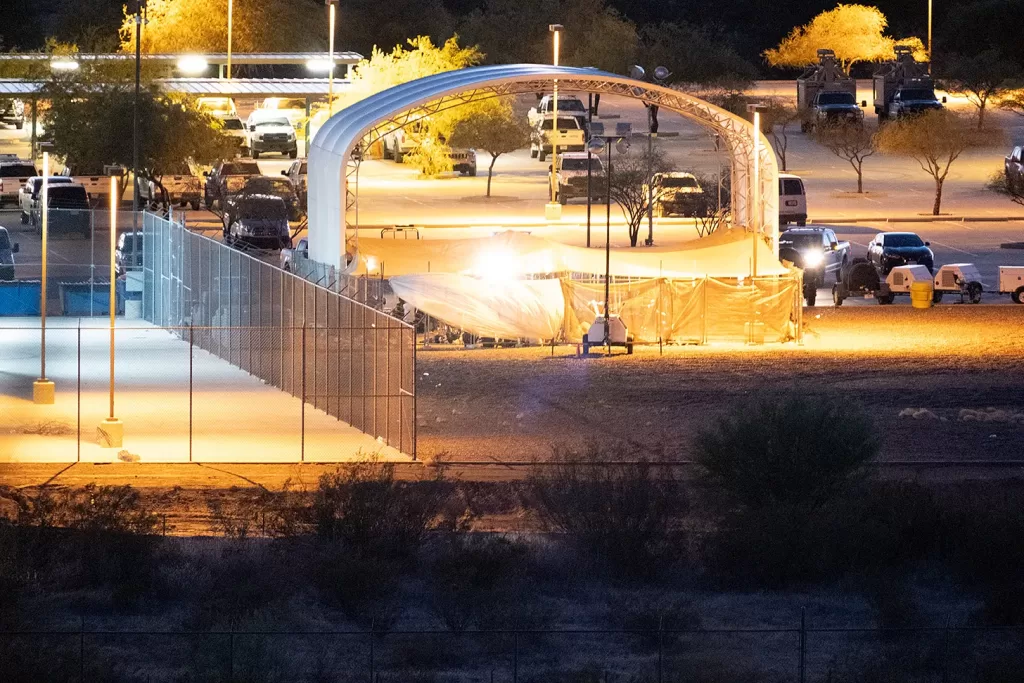
Editor’s note: This article originally appeared in The Border Chronicle on Aug. 15, 2023, and is re-posted here with the author’s permission. You can find the original article at https://www.theborderchronicle.com/p/ajo-residents-activists-protest-inhumane.
It felt like walking into the mouth of a furnace as we climbed the hill, near Ajo, Arizona, sidestepping cholla and cactus. The Southwest had been under an excessive heat warning for weeks. It was so hot, a local resident claimed that the saguaros at the Organ Pipe Cactus National Monument were boiling inside.
Wearing hats and carrying binoculars, Ana Sanchez and Harvey Ortiz unfolded two chairs and got their clipboard ready. They’d be the first three-hour shift of a 24-hour stakeout Aug. 12 behind the Ajo Border Patrol station, which is about 10 miles south of town, and near the small desert outpost called Why.
I had driven down from Tucson to investigate what was happening at the remote Border Patrol facility after residents in Ajo had sounded the alarm that people were being held outdoors in a chain-link enclosure during a deadly heatwave. Reports from local Border Patrol agents, troubled by the suffering they were seeing, and lack of resources to handle the number of asylum seekers, raised further alarm, Sanchez told me.
Humanitarian volunteers and activists had come from as far away as Yuma and Phoenix to Ajo for the weekend to participate in the 24-hour stakeout Aug. 12, and at a protest the following afternoon in front of the Border Patrol facility.
The goal of the 24-hour stakeout was to document what was happening inside the enclosure, and to pressure the Border Patrol to release the people being detained there, said Sanchez. From the side of the hill, Sanchez peered through binoculars at the facility hundreds of feet below us, where a white sheet now hung at the back of the chain-link enclosure, blocking our view. “That’s new,” Sanchez said. “It wasn’t there before.”

On July 21, The Intercept photographed dozens of people being held in the chain-link enclosure amid 108 degree weather. Inside the pen were a few metal bleachers, a fan, and a mister, sitting in the full sun.
Since then, Sanchez suspected that Border Patrol had put up the white sheet to prevent journalists or activists from seeing inside. They’d installed a shade cloth over the enclosure, since the article had been published. But people were still being held outside in the blistering heat. Driving from Tucson I’d watched as the temperature gauge in my car ticked up to 105 degrees. As we all strained to see something or somebody inside the enclosure, a hot breeze occasionally moved the fabric, revealing a quick glimpse of someone sitting on the ground or standing.
The makeshift screen seemed apropos for an agency so often accused of hiding its activities. The more that Sanchez and others in town wanted to know, the more barriers Border Patrol put up.

Border Patrol “has surged personnel and transportation resources to respond to the encounters in the area—some of the hottest, most isolated, and dangerous area of the southwest border,” a spokesperson for Customs and Border Protection wrote to me in an email, after I sent him several questions about the people being detained outside.
At the small Ajo facility, women and children were kept inside, the spokesperson said, and men were rotated to the enclosure if it became too crowded inside. “In this location, they are provided with a large canopy and other shelter from the sun, large misting fans, evaporative air conditioners, hot meals, water, and bathroom facilities.” They were also medically assessed, and agents kept a close watch on the health of people being detained there, he said.
But these claims were hard for many of the humanitarians to believe, when the agency’s Tucson sector, which includes Ajo, had been sued by the ACLU in 2015 for detaining people in inhumane and deplorable conditions. “I live eight miles from the Border Patrol station,” said John Orlowski, an Ajo resident who participated in the stakeout. “Transparency is extremely low. We get hints and rumors of what happens with Border Patrol. But we never really know.”
Morgan Riffle, another resident, who helped organize the actions, said she’d heard from Border Patrol agents who had requested more resources to take care of people at the facility but had been denied by upper management. “I’m not sure why,” she said. “But they’re not getting what they need.”
People in Ajo wanted to show solidarity with the people being held in the enclosure, out of sight and now hidden behind the white fabric. In the latter part of the stakeout, a Border Patrol surveillance truck rolled up to the perimeter of the facility’s fence, and a tall pole with a large camera pointed toward the stakeout volunteers on the hill. Each side sized up the other. Only one side had billions of dollars in resources, though, while the other had a couple of folding chairs and a clipboard.
And yet it was the former which said it had been caught by surprise when asylum seekers started arriving in the desert. “They claim they were caught unprepared,” said Sanchez. “But with all the coverage of migration trends, the intelligence capabilities they have, I find it unlikely that it was a complete surprise. It’s more a level of mismanagement. And I might go even further to say it’s just another aspect of deterrence to make the process so strung out and painful for anyone who pursues it.”
The increase in asylum seekers, Ajo residents and Border Patrol say, began after Title 42 ended in early May. People started arriving from as far away as Mauritania, India, and Senegal, and presenting themselves to Border Patrol agents at gaps in the border wall left open for wildlife and monsoon rains at the rugged Organ Pipe Cactus National Monument.
This stretch of Sonoran Desert couldn’t be more remote, or deadly, for the growing number of asylum seekers and migrants passing through during this unusually hot summer. Last year, 173 bodies were recovered in the southern Arizona desert, and this year was already on its way to surpass that number.
On Sunday morning, I headed south toward Organ Pipe. Driving from Tucson I’d passed a few school buses painted white and with blacked-out windows, which are so ubiquitous along the border. With the darkened windows, it was impossible to see inside, but I imagined it was full of asylum seekers from Ajo, being transported north to larger Border Patrol facilities. There, it would be determined whether they could further their asylum claims or be deported.
As I made my way down the highway, green and white Border Patrol vans, and black vans on loan from the U.S. Marshals sped past me on the highway. Near the border road along the wall, there were a handful of khaki tents, a mobile surveillance tower with an American flag hanging from it, and about a half dozen agents sitting in their air-conditioned vehicles waiting for something to happen. It was the middle of the afternoon and blistering hot. Most of the asylum seekers, I’d been told, arrived in the early morning hours, then waited for Border Patrol to pick them up.
I didn’t see anyone except a small group of men near the wall who were quickly whisked away by Border Patrol. The only activity happening were three volunteers from Humane Borders, a Tucson nonprofit organization, who were filling up blue water barrels, which were shielded by tents. Even so, the water was hot. They were also picking up hundreds of empty plastic water bottles left behind by people, waiting at the wall. Occasionally, one of them told me, they had to place women and children in their air-conditioned truck, because they were on the verge of fainting from the heat, while they waited for Border Patrol.
Up and down the border in Mexico, I’d heard that asylum seekers had had mixed results with the CBP One app, which the Biden administration had announced in January would be the only way for people to apply, in defiance of U.S. asylum law. It required a newer phone, and good Wi-Fi, both of which were hard to obtain while living in a shelter or on the street. Nonprofit organizations, which help asylum seekers, filed a lawsuit in July charging that the Biden administration was unlawfully turning people back.
Unable to make the app work, some asylum seekers in Ciudad Juárez, Tijuana, and other locations, are lining up on the Mexican side of the international bridges, hoping to plead their case in person to an U.S. agent. But Mexican officials—working in tandem with the U.S.— never let them touch the U.S. side of the bridge. With the bridges closed, some people, like those in Organ Pipe or Yuma, are arriving at the gaps in the wall. While others hire guides to take them through the desert in the punishing heat.
Two of the Humane Borders volunteers were retirees who lived in Ajo, while another was a civil engineer who had driven down from Phoenix. “I plan on being here every Sunday through this heatwave,” the civil engineer told me. The wait at the wall can sometimes be long, and there are no toilets or food. The volunteers provide water and snacks and can deploy tents for shade if needed. Border Patrol has allowed them to work along the wall, but they’re the only nonprofit allowed to do so. “Maybe we don’t save lives, but at least we remove some of their suffering,” said the civil engineer.
One of the volunteers showed me an animal claw wrapped in leather, and fashioned into a necklace, possibly an amulet for good luck he’d found in the dirt. I found another necklace, with Catholic saints embossed in metal. It made me wonder whether some Border Patrol agents were forcing asylum seekers to leave behind religious and other sacred items as they had in Yuma last year. The ACLU had intervened there, and now agents were supposed to allow asylum seekers to keep their possessions. But who really knew what was happening here. The border road was closed, even though it was federal park land a sign had gone up saying it was no longer opened to the public.
A week earlier I’d been near Sasabe—150 miles east in an equally punishing stretch of desert, and I’d spoken to an indigenous Guatemalan woman who stood on the Mexican side of the wall with her son. We spoke through the gaps in the steel bollards. “Why don’t you request asylum?” I’d asked her. “My son is 20, so they won’t give it to him,” she said. “And I won’t let him go alone.” The boy’s father had left for the United States 15 years ago, she said and never come back. “He abandoned us,” she told me. “And we’re going to find him.”
She was waiting for the guides to cross them, she said. “It’s a long way in the desert. You could both die,” I told them. She spoke to her son softly in a Mayan dialect. She began to cry, and the boy looked like he was trying hard to swallow his fear. We stood there contemplating the journey ahead of them in silence. Dora Rodriguez, a humanitarian from Tucson who was with me, tried to console her. I told the woman that Dora, who had fled the civil war in El Salvador in the eighties, had made the journey through the desert too. Though it felt cruel to tell her that 13 people had died, and Dora had nearly died too. So we said farewell to them, after handing them some water and food through the small space where we could touch hands. “If God blesses us, we will make it,” she said in Spanish.
I thought of the Mayan woman as I stood on the hill near Ajo, trying to make that connection across the divide. Nothing was fair, nothing made sense. But somewhere beyond that manmade barrier, there was still hope.
Melissa del Bosque, of The Border Chronicle, is a longtime journalist based in Tucson, Arizona, who has spent decades writing about border communities in Mexico and the United States. You can find more of her work at theborderchronicle.com.
